Kun tilaa on hieman enemmän ja halutaan laajentaa bassotoistoa, tämä stereojärjestelmä toimii saumattomasti tarjoten neutraalin, transparentin ja hallitun bassotaajuuksien toiston aina 24 hertsiin saakka.
Ratkaisun tuotteet:


Kun tilaa on hieman enemmän ja halutaan laajentaa bassotoistoa, tämä stereojärjestelmä toimii saumattomasti tarjoten neutraalin, transparentin ja hallitun bassotaajuuksien toiston aina 24 hertsiin saakka.
Ratkaisun tuotteet:





104 dB

47 Hz - 25 kHz (-6dB)

H 299 x W 189 x D 178 mm, with Iso-Pod™ (muunna tuumiksi)



103 dB

24 Hz - 85 Hz (-6dB)

H 410 x W 350 x D 319 mm, (muunna tuumiksi)

Active Crossovers

Directivity Control Waveguide (DCW™)

Intelligent Signal Sensing (ISS™)

Iso-Pod™ Stand

Minimum Diffraction Enclosure (MDE™)

Optimized Amplifiers

Protection Circuitry

Reflex Port Design

Room Response Compensation

Versatile Mountings

Bass Management

Laminar Spiral Enclosure (LSE™) Technology

Aktiiviset jakosuotimet jakavat audiosignaalin taajuuskaistoihin, jotka ohjataan erillisiin tehovahvistimiin. Vahvistimet on kytketty kyseiselle taajuuskaistalle optimoituihin kaiutinelementteihin.
Aktiivikaiuttimissa käytetään sekä digitaalisia että analogisia jakosuotimia. Genelecin digitaalisissa aktiivijakosuotimissa on myös muita signaalinkäsittelytoiminnallisuuksia, kuten elementtien suojaus, lentoaikakompensointi ja taajuuskorjaus.
Genelecin analogisissa aktiivijakosuotimissa perustuu elektronisiin komponentteihin, jotka käsittelevät matalatasoista signaalia ennen tehovahvistusta. Aktiiviset jakosuotimet eroavat toimintaperiaatteeltaan passiivisista jakosuotimista, joissa käsitellään voimakkaita signaaleja, suurta virtaa ja toisinaan myös suurta jännitettä.
Tyypillisessä kaksitiekaiuttimessa tulosignaali jakosuodatetaan kahdelle erilliselle tehovahvistimelle, joista toinen ohjaa bassoelementtiä ja toinen diskanttielementtiä.
Directivity Control Waveguide (DCW™) -suuntain tuottaa tasaisen taajuusvasteen laajalle kuuntelualueelle.

Vallankumouksellinen Directivity Control Waveguide™ (DCW™) -teknologia parantaa huomattavasti suoraan säteilevän monitiekaiuttimen suorituskykyä.
Tavoite on sovittaa taajuusvaste ja elementtien suuntaavuus kaiuttimessa. Lopputuloksena saavutetaan erinomainen taajuusvaste sekä kaiuttimen akustisella akselilla että sivusta mitattuna.
Parantunut kontrolloitu suuntaavuus vähentää huoneheijastumia kuuntelupaikalle. Tämä parantaa stereokuvaa ja asettaa vähemmän vaatimuksia huoneakustiikalle.
DCW-teknologia parantaa elementin herkkyyttä jopa +6 dB:ä, mikä mahdollistaa suuremman kokonaisäänenpaineen vähentäen samalla säröä ja parantaen luotettavuutta.
###DCW™-suuntaimen tärkeimmät edut:

Genelec kehitti vuonna 2013 Intelligent Signal-Sensing -piirin, joka täyttää sekä ErP-direktiivin vaatimukset että Genelecin omat direktiiviä tiukemmat vastuullisuusvaatimukset.
ISS™-piiri seuraa kaiuttimien signaalinsyöttöä ja havaitsee, milloin signaali on käytössä. Jos ISS-piiri ei havaitse audiosignaalia hetkeen, se asettaa kaiuttimen valmiustilaan, jossa kaiuttimen virrankulutus on alle 0,5 wattia. Kun syöttösignaali havaitaan, kaiutin kytkeytyy päälle itsestään. Kaiutinjärjestelmä alkaa siis säästää sähköä heti, kun työskentely katkeaa.
Jokaisen kaiuttimen taustalevyssä on huonevasteen säätimien vieressä ISS Disable -kytkin. Kun päävirtakytkin on asennossa ON, ISS™-toiminto on oletusarvoisesti päällä.

Jos ISS-toimintoa ei haluta käyttää, se voidaan poistaa käytöstä kääntämällä ISS Disable -kytkin asentoon ON. Tällöin kaiuttimen virransyöttöä ohjataan päävirtakytkimestä.
Päävirtakytkin katkaisee kaiuttimen virransyötön kokonaan.

Vaikka vapaasti seisovien kaiuttimien alle suositellaan yleisesti tukevia jalustoja, on varsin yleistä että kaiuttimet sijoitetaan suoraan pöydälle tai äänipöydän mittarisillalle. Tällaisesta sijoituksesta aiheutuu kuitenkin haitallisia lieveilmiöitä: Kaiuttimen suuntaus kohti kuulijaa on vaikeaa ja kaiuttimen sekä alustan välille syntyy haitallisia mekaanisia värinöitä. Kaiuttimen ollessa pöydällä työtasosta aiheutuu heijastumia, jotka aiheuttavat kampasuodinilmiöstä johtuvaa taajuusvasteen vääristymistä.
Genelec on kehittänyt näiden ongelmien ratkaisemiseksi tehokkaan ja käytännöllisen Isolation Positioner/Decoupler (Iso-Pod™) -alustan, joka kiinnitetään jousella kaiuttimen alumiinikoteloon. Alusta on valmistettu joustavasta kumimaisesta materiaalista. Tukevasti sekä pysty- että vaaka-asentoon Iso-Pod-alustan päälle asettuvaa kaiutinta voidaan kallistaa ±15 asteen kulmaan. Kaiuttimen akustinen akseli voidaan kohdistaa tarkasti kohti kuuntelijaa säätämällä kaiuttimen kulmaa Iso-Pod-alustan päällä.
Mekaaniset eristys- ja vaimennusominaisuudet vähentävät tukipinnoista syntyvän haitallisen värähtelyn aiheuttamaa keskiäänen värittymistä.
Innovatiivinen Iso-Pod™-alusta on oleellinen osa Genelecin kaiutinmuotoilua ja se tarjoaa huomattavia käytettävyyteen sekä äänenlaatuun vaikuttavia etuja.
Etulevyn akustisista epäjatkuvuuskohdista syntyvä diffraktio on tyypillinen vapaasti sijoiteltavan kaiuttimen ongelma. Kotelon terävät kulmat aiheuttavat heijastuksista johtuvia toisioäänilähteitä, jotka värittävät ääntä ja heikentävät äänikuvan tarkkuutta.
Parantaakseen vapaasti sijoiteltavan kaiuttimen taajuusvasteen sekä tehovasteen tasaisuutta, Genelec on kehittänyt innovatiivisen Minimum Diffraction Enclosure (MDE™) -kaiutinkotelon, jossa on kaarevat sivut sekä pyöristetyt kulmat. Poikkeuksellisen tasaisen taajuusvasteen lisäksi kotelorakenteella saavutetaan erinomaiset äänikuvaominaisuudet.
Kompaktin ja tyylikkään ulkoasun saavuttamiseksi kotelon materiaaliksi on valittu painevalettu alumiini, joka mahdollistaa kotelon kokoon suhteutettuna suuren sisätilavuuden bassoelementin herkkyyden maksimoimiseksi. Alumiini on kevyttä, jäykkää ja hyvin vaimentavaa, joten se on erinomainen materiaali ohutseinäisen ja akustisesti "kuolleen" kotelon valmistamiseen. Alumiinikotelo suojaa tehokkaasti elektromagneettiselta säteilyltä ja se toimii myös vahvistimien jäähdytyselementtinä. Kotelo valetaan kahtena kappaleena, jolloin se pystytään avaamaan helposti esimerkiksi huoltoa varten.
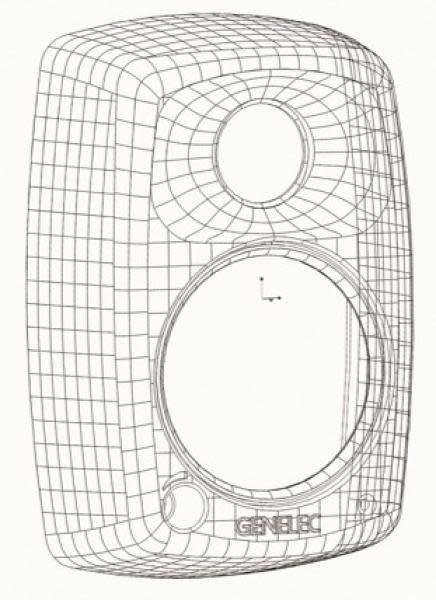
Directivity Control Waveguide (DCW™) -suuntain integroidaan MDE™-koteloon hallitun suuntaavuuden saavuttamiseksi. Vakiosuuntaavuuden alarajataajuus määräytyy suuntaimen koon perusteella, jolloin suuremmalla suuntainpinta-alalla saavutetaan hallitumpi suuntaavuuskäyttäytyminen. Hallittu sivukenttäsäteily mahdollistaa suuren käyttökelpoisen kuuntelualueen, mikä on erittäin tärkeää monikanavaisessa äänentarkkailussa. Hallittu suuntaavuus vähentää myös rajapintaheijasteiden merkitystä, jolloin monitorointijärjestelmä toimii johdonmukaisesti erilaisissa akustisissa ympäristöissä.

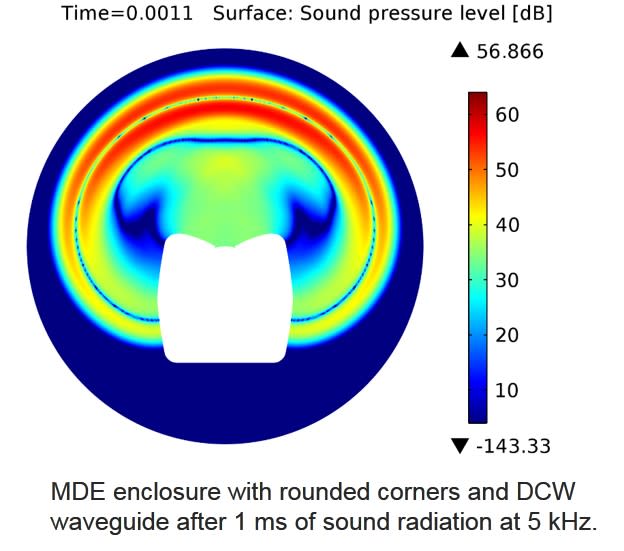

Elektroniset jakosuotimet jakavat audiosignaalin taajuuskaistan osiin, jotka voidaan ohjata erillisiin vahvistimiin. Vahvistimet on liitetty kyseiselle taajuuskaistalle optimoituihin muuntimiin.
Tyypillisessä kaksitiekaiuttimessa aktiivinen jakosuodin tarvitsee kaksi vahvistinta: yhden bassoelementille ja toisen diskanttielementille. Vahvistimet liitetään suoraan aktiivikaiuttimien elementteihin, jolloin vahvistimien kuormitus on tunnettu ja yksinkertaisempi. Jokaisella elementtikohtaisella vahvistimella on vain rajallinen taajuusalue, jota se vahvistaa (vahvistin sijoitetaan aktiivisen jakosuotimen taakse), mikä yksinkertaistaa rakennetta.

Kriittisissä audiotuotantoympäristöissä on ratkaisevaa, että monitorointijärjestelmä on luotettava ja aina käytettävissä. Yksi tärkeimmistä syistä Genelecin menestykseen lähetystarkkaamokäytössä on tuotteidemme luotettavuus. Luotettavuuden takeena on sisäinen suojapiiri, joka on ollut kaikissa tuotteissa vuodesta 1978 lähtien.
Suojapiiri ehkäisee elementtien vikatiloja havaitsemalla signaalitasoja. Mikäli signaalissa esiintyy yhtäkkisiä piikkejä tai jatkuvia liian korkeita tasoja, suojapiiri laskee signaalin tasoa automaattisesti. Suojapiirin toiminta ei luonnollisestikaan vaikuta äänenlaatuun millään tavalla työskenneltäessä kaiuttimen määritellyissä käyttöolosuhteissa. Se vain ehkäisee signaaleja rikkomasta kaiutinta.

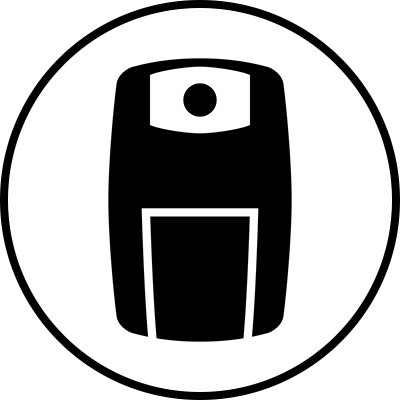
Genelec käytti bassorefleksirakennetta jo ensimmäisessä tarkkailukaiuttimessaan S30:ssa vuonna 1978. Genelec on siitä lähtien tutkinut ja kehittänyt refleksiputken suorituskykyä sekä tehokkuutta. Kehitystyön tavoite on ollut parantaa bassotoiston ulottuvuutta ja äänenpainekapasiteettia erinomaisen matalien taajuuksien artikulaation ja tarkkuuden tuottamiseksi.
Sekä bassoelementti että refleksiaukko vaikuttavat refleksikotelon kokonaissäteilyyn. Suurin osa säteilystä on lähtöisin elementistä, mutta refleksikotelon resonanssitaajuudella elementin liikepoikkeaman amplitudi on pieni, jolloin suurin osa säteilystä tulee aukosta.
Virtausnopeuden minimoimiseksi putken poikkipinta-alan täytyy olla suuri. Kaiutinkotelon koko rajoittaa usein refleksiputken pituutta.
Pitkä kaareva refleksiputki maksimoi ilmavirtauksen, jotta kaiutin pystyy tuottamaan syvän bassotoiston ilman kompressiota. Putki päättyy leveään pyöreäreunaiseen aukkoon, joka sijaitsee kotelon takana minimoiden putken virtausääniä ja tuottaen erinomaisen bassoartikulaation.
Putken kaareva muoto on tarkoin suunniteltu ja se vähentää virtausääniä, kompressiota ja säröä. Putken sisäpään muotoilu minimoi suorille refleksiputkille tyypillisiä yskähdysääniä ja turbulenssia.
Huolellisesti suunniteltu refleksiputken rakenne vähentää bassoelementin liikepoikkeamaa ja parantaa matalien taajuuksien toiston lineaarisuutta sekä äänenpainekapasiteettia.
Huoneakustiikan ja kaiuttimen säteilyn välinen suhde on monimutkainen asia. Jokainen tila vaikuttaa tarkkailukaiuttimen vasteeseen omalla tavallaan – esimerkiksi heijastavat ja vaimentavat tilat – samoin kuin kaiuttimen sijoittaminen seinää vasten tai irti seinästä.
Kaikissa Genelecin kaiutinjärjestelmissä on huonevasteen korjaus, joka kompensoi tilan vaikutuksia äänentoistoon ja tuottaa tasaisen taajuusvasteen kuuntelupaikassa.
Genelecin analogiset kaiutinjärjestelmät tarjoavat monipuoliset huonevasteen säätömahdollisuudet. Säätömahdollisuuksia ovat (kaiutinmallista riippuen):

Matalilla taajuuksilla käytettävissä on kaksi pääsäätöä. Bass Tilt toimii hyllysuodattimena, kun taas Bass Roll-off sallii optimoida matalien ja erittäin matalien taajuuksien taajuusvastetta eri kohteissa. Bass, Midrange ja Treble Level ovat käytettävissä isoissa järjestelmissä. Nämä säädöt optimoivat eri päästökaistojen välistä suhteellista tasapainoa.
Kunkin kaiuttimen käyttöohje ja datalehti sisältävät luettelon erilaisten asennusten ensisijaisista huonevasteasetuksista. Ne on määritetty pitkän käytännön kokemuksemme ja erilaisissa akustiikkaympäristöissä tekemiemme mittausten perusteella.
Genelecin SAM-järjestelmät ovat kokonaisvaltainen, ratkaisukeskeinen, älykkäästi verkostoituva tuotevalikoima, jonka kaikki tuotteet käyttävät Genelec Loudspeaker Manager (GLM™) -ohjelmistoa ja automaattisesta AutoCal™-kalibrointitekniikkaa.
Genelec AutoCal on alan ensimmäinen täysin integroitu ja automaattinen prosessi GLM-ohjausverkkoon liitettyjen kaiuttimien mittaamiseen, analysointiin ja kalibrointiin. Järjestelmä mittaa kuuntelualueen vasteen ja tekee tarvittavat kompensaatiot matalilla ja matalilla keskitaajuuksilla ja minimoi näin huoneakustiikkaa heikentävät poikkeamat ja eri kuuntelupaikkojen väliset erot. AutoCal sovittaa kaikkien verkon kaiuttimien suhteelliset tasot, kompensoi etäisyyseroja ja säätää kaikkien verkon alabassokaiuttimien jakosuodinvaiheet (AutoPhase).
Acoustic Response Editor tarjoaa tarkan graafisen esityksen mitatusta vasteesta, suodatuksen kompensoinnista ja kunkin kaiuttimen järjestelmävasteesta sekä mahdollisuuden akustiikka-asetusten manuaaliseen säätämiseen.

Genelecin kaiuttimissa on monipuoliset ripustusmahdollisuudet, jotka tekevät asennuksesta helppoa kaikissa kohteissa. Oikein sijoitetut kaiuttimet käyttäytyvät ihanteellisesti erilaisissa käyttöympäristöissä.
Laaja lisävarustevalikoimamme ja painevalettujen alumiinikoteloiden takalevyihin integroidut kiinteät M6-kiinnityspisteet tarjoavat ratkaisun useimpiin asennustilanteisiin. Pienissä kaiutinmalleissa kotelon pohjassa on 3/8-tuuman kierreinsertti, jota käyttäen kaiutin voidaan asentaa tukevaan mikrofonitelineeseen tai jalustaan. Suuremmissa ja painavammissa malleissa on M10-kiinnityspisteet. Lattiatelineisiin on saatavilla myös mallikohtaiset Iso-Pod jalusta-adapterit, joiden avulla saavutetaan kattavat säätömahdollisuudet sekä hyvä mekaaninen eristys kaiuttimen ja jalustan välille.
Näiden ominaisuuksien ansiosta tuotteitamme käytetään nykypäivänä ammattikäyttökohteiden lisäksi sekä julkistiloissa että kotikohteissa kaikkialla maailmassa.
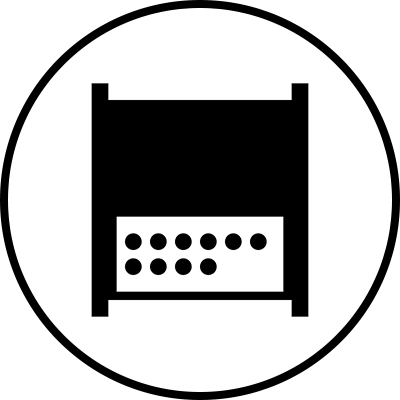
Bassonhallinnan periaate on, että pääkanavien ja Low Frequency Effect (LFE) -kanavan bassosisältö ohjataan ja toistetaan vain niitä käsittelemään kykenevistä kaiuttimista eli joko pääjärjestelmäkaiuttimista tai yhdestä tai useammasta alabassokaiuttimesta.
Stereoäänentoistossa tulee toistaa signaalit 20 hertsistä 20 kilohertsiin. Suuret monitietarkkailukaiutinjärjestelmät toistavat tällaiset laajat taajuuskaistat tasaisesti. Monikanavaisten äänentoistojärjestelmien, ammattimaisten äänentoistojärjestelmien ja kotiäänentoistojärjestelmissä on pystyttävä toistamaan jokaisen kanavan taajuudet 20 hertsistä 20 kilohertsiin. Se vaatii pääkaiuttimien, alabassokaiuttimien ja jakosuodinelektroniikan yhteistoimintaa.
Bassonhallintajärjestelmä käyttää joko analogisia elektroniikkapiirejä tai ohjelmistopohjaista suodatusta, joka suodattaa matalien taajuuksien informaation pääkanavilta ja ohjaa sen yhteen tai useampaan alabassokaiuttimeen.
LFE-kanavaa voidaan monitoroida myös alabassokaiuttimen kautta ja lisätä muiden pääkanavien mataliin taajuuksiin. Siksi bassonhallinnan tärkein tavoite on taata kaikkien kanavien koko taajuuskaistan tarkka monitorointi.

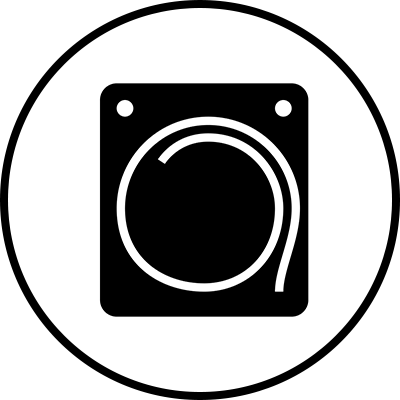
Viime vuosikymmenen aikana subwoofereihin kohdistuneet akustiset vaatimukset ovat konkreettisesti kasvaneet sellaisiksi, etteivät perinteiset suunnitteluperiaatteet enää riitä. Alan markkinajohtajien velvollisuus on tehdä rohkeita kokeiluja parhaan mahdollisen suorituskyvyn saavuttamiseksi.Genelecin insinöörit hyväksyivät heille asetetun haasteen useiden vuosien kokemuksella akustiikan tutkimuksesta ja tietotaidosta. LSE™ Laminar Spiral Enclosuren kaareva muoto on tulosta heidän työstään.

Spiraalimaisella rakenteella voidaan bassorefleksikaiuttimessa kriittinen putki integroida muuhun kotelorakenteeseen tavalla, joka perinteisssä suorakaiteenmuotoisessa kotelossa olisi mahdotonta. LSE™ -rakenteella voidaan tilavuudeltaan suhteellisen pieneenkin koteloon rakentaa pitkä ja pinta-alaltaan suuri ja samalla kertaa muuttuvaprofiilinen refleksiputki, jonka virtausominaisuudet säilyvät lineaarisina hyvinkin suurilla äänenpaineilla ja matalilla taajuuksilla. Myös putken päät voidaan muotoilla virtausteknisesti edullisesti, ja virtausääniä vähentää edelleen se rakenteesta johtuva etu, ettei putken kotelon seinänä jatkuva sivu käytännössä pääty lainkaan.


Genelec products use various damping materials such as glass fiber wool, linen fiber wool, and polyester fiber based material (PES). The tables presented below provide a detailed listing of our monitor models and the type of damping material used in each model.
During operation, the air moving in and out of the monitor loudspeaker or subwoofer bass reflex openings does not emit significant amounts of fiber particle dust. The PES wool as material does not emit dust. The linen wool, and glass fiber wool can emit minimum amounts of dust during very high sound level operation. This fiber dust is not hazardous to health.
| SAM™ Studio Monitors | Damping material type |
|---|---|
| 1032C | PES |
| 8320A | PES |
| 8330A | PES |
| 8340A | PES |
| 8350A | PES |
| 8130A | PES |
| 8240A | PES |
| 8250A | PES |
| 8331A | PES |
| 8341A | PES |
| 8351A | PES |
| 8351B | PES |
| 8361A | PES |
| S360 | PES |
| 8260A | Linen wool |
| 1238CF | Linen wool |
| 1238DF | Linen wool |
| 1237A | Linen wool |
| 1238A | Glass wool |
| 1238AC | Glass wool |
| 1234A | Glass wool |
| 1234AC | Glass wool |
| 1236A | Glass wool |
| SAM™ Studio Subwoofers | Damping material type |
|---|---|
| 7260A | Linen wool |
| SE7261A | Linen wool |
| 7270A | Linen wool |
| 7271A | Linen wool |
| 7350A | Linen wool |
| 7360A | Linen wool |
| 7370A | Linen wool |
| 7380A | Linen wool |
| 7382A | Linen wool |
| 8000 Series Studio Monitors | Damping material type |
|---|---|
| 8010A | PES |
| 8020D | PES |
| 8030B | PES |
| 8030C | PES |
| 8040B | PES |
| 8050B | PES |
| 1000 Series Studio Monitors | Damping material type |
|---|---|
| 1032B | Linen wool |
| 1037C | Linen wool |
| 1038CF | Glass wool |
| 1038B | Glass wool |
| 1038BC | Glass wool |
| 1034B | Glass wool |
| 1034BC | Glass wool |
| 1039A | Glass wool |
| 1035B | Glass wool |
| 1036A | Glass wool |
| M Series Studio Monitors | Damping material type |
|---|---|
| M030 | PES |
| M040 | PES |
| 7000 Series Studio Subwoofers | Damping material type |
|---|---|
| 7040A | Linen wool |
| 7050B | None |
| 7050C | Linen wool |
| 7060B | Linen wool |
| 7070A | Linen wool |
| 7071A | Linen wool |
| 7073A | Glass wool |
| G Series Active Speakers | Damping material type |
|---|---|
| G One | PES |
| G Two | PES |
| G Three | PES |
| G Four | PES |
| G Five | PES |
| F Series Active Subwoofers | Damping material type |
|---|---|
| F One | None |
| F Two | PES |
| Home Theater Speaker Series | Damping material type |
|---|---|
| HT210B | Linen wool |
| HT312B | Glass wool |
| HT315B | Glass wool |
| HT320BC | Glass wool |
| HT324A | Glass wool |
| HT324AC | Glass wool |
| HT330A | Glass wool |
| Home Theater Subwoofer Series | Damping material type |
|---|---|
| HTS3B | None |
| HTS4B | None |
| HTS6 | Glass wool |
| 4000 Series Installation Speakers | Damping material type |
|---|---|
| 4010A | PES |
| 4020B | PES |
| 4020C | PES |
| 4030B | PES |
| 4030C | PES |
| 4040A | PES |
| Architectural Speaker Series | Damping material type |
|---|---|
| AIC25 | PES |
| AIW25 | PES |
| AIW26 | Linen Wool |
| AIW26B | Linen Wool |
| AOW312 | Glass wool |
| 5041A | Linen Wool |
The 7050B subwoofer has balanced XLR IN/OUT connector pairs for five main channels and a dedicated LFE input connector for the LFE channel. Connect the signal cables from your source to the female XLR "IN" connectors on the lower connector row. Next connect XLR cables from the corresponding "OUT" male XLR connectors on the upper row to the input connectors of each 8020C monitor.
Turn the volume control knob on all 8020C’s monitors fully clockwise and switch the "Bass Roll-off" dip switch (switch 2) on all 8020C’s to "ON". This switch actuates an 85 Hz high-pass filter on the 8020C’s matching them to the main channel low-pass filter of the 7050B.
Alternatively you can connect to the 7050B a stereo pair of 8020C monitors by routing the signal cables from the source to the input connectors of the main monitors and an another pair of cables from the main monitors' output connectors to the "IN" connectors on the 7050B. In this configuration the volume controls on the main monitors affect the playback level of the 7050B too. The "Bass Roll-off" switch on the main monitors must also be switched to "ON" (switch 2).

The main goal in the alignment of a multichannel system is to set the subwoofer output level the same as the sound output level of the main monitor system. The LFE output of the mixing desk or decoder should be connected to the LFE input on the subwoofer.
For the 7050B, 7060B, 7070A, 7071A, 7073A products:
The LFE input has the same sensitivity as all other signal inputs unless the ‘LFE +10 dB’ DIP switch is ON. The switch is used when there is no +10 dB gain in the LFE channel output. The switch is set to 0 dB when there is already a +10 dB additional gain in the LFE channel output.
To ensure repeatable results in the finished product, the SMPTE (Society of Motion Pictures and Television) has set standard monitoring levels for cinema post-production work. The SMPTE reference level at the listening position is 85 dB SPL, on C weighted/slow scale. The input signal to the monitors is -20 dB FS (rms) full bandwidth pink noise. The SMPTE RP200 uses an electrical reference level of -18 dB FS.
For music mixes, there are no standardized levels. The level that the engineer chooses is arbitrary and based on personal taste, as is the level chosen by the end user. The level is typically 75 dB SPL for television audio work and 75-95 dB SPL for music production work.
Monitors are first calibrated to have flat response at the listening position. This is achieved by doing the following:
Calibrate the monitor frequency responses using an acoustical measuring system with the subwoofer bypassed or disconnected. Then connect the Genelec subwoofer and adjust the subwoofer level, bass roll-off and phase so that the measured combined frequency response of the subwoofer and the monitor extends flat to the LF cut-off of the subwoofer, paying special attention to the subwoofer to monitor crossover point.
If acoustic measurement system is not available for aligning the system, then follow the guidelines that can be found in the operating manual for adjusting the frequency response:
Connect the Genelec 5.1 system and play broadband pink noise signal (20 Hz – 20 kHz) through the subwoofer and one of the monitors, for example the centre channel monitor. Adjust the acoustic settings in the subwoofer and monitors so that the level in each band on the RTA analyser reads the same value. Then, set the output level of each channel to give the same acoustical level at the listening position.
You need to have filtered pink noise to calibrate the levels of the subwoofer and the main channels. You can use a copy of the TMH Corporation 'Multichannel Studio Test Tape' that includes the various test signals required.
Pink noise filtered to a passband 500 Hz to 2 kHz is used for adjusting the monitor levels, and between the frequency range 20 Hz to 80 Hz is used for calibrating the subwoofer level. Please note: If the standard recorded level of filtered pink noises is -18 dBFSrms for SMPTE RP200's (-20 dBFSrms for SMPTE) and then the absolute level calibration can be made so that the sound level meter reads a level 2 dB lower than specified for broadband pink noise. This is because there is less energy due to band limiting of the band-pass noise.